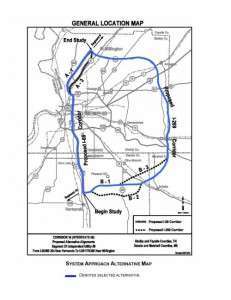Perhaps what local government needs most is a Department of Connecting the Dots.
While one public agency talks about creating a workforce that can compete in the knowledge economy, another gives tax freezes to companies that perpetuate low-wage, low-skill jobs.
While one government launches a “sustainability agenda,” no government seems able to rein in sprawl-inducing projects that make Memphis the most economically segregated of the top 50 metros.
While one department talks about keeping and attracting twenty-first century workers, another operates a public transit system that’s barely in the late-twentieth century.
While one division of city government works to revitalize urban neighborhoods, the projects of another make them more disconnected and less walkable and bikable.
The Symbol Of Unconnected Dots
If there’s a poster child for this disconnect, it is I-269. It’s essentially the latest gift to developers, but for Memphis, it’s the gift that keeps on giving, fueling trends that already batter the city’s ability to compete.
The Brookings Institution recently released a report that showed that jobs created within three miles of downtown are decreasing while those more than 10 miles from downtown are climbing. It underscored an earlier study by the think tank that showed that Memphis is a national leader in the loss of middle-income families and neighborhoods.
Meanwhile, the economic segregation caused by sprawl results in concentrated poverty that is the seedbed for our city’s most serious problems and derails our best efforts to address them. Projects like Tennessee Highway 385 and I-269 promise only to make them worse, because every problem becomes harder to deal with in cities that are economically segregated.
In other words, at the precise time when every city, county, and state agency should be focused on encouraging infill redevelopment that revives and stabilizes Memphis neighborhoods, our transportation investments hollow them out, and leaders appear unable to turn the tide and abandon the idea that sprawl is “growth.”
Hammering It Home
To their credit, both city and county governments opposed and lobbied hard to prevent I-269 from ever happening; however, in a high stakes game of political gamesmanship, Mississippi held all the cards, and former U.S. Senate Majority Leader Trent Lott owned the deck.
Lott was supported by former U.S. Representative from Texas and House Whip Tom (Hammer) Delay, who had earlier suggested that the I-69 Coalition hire someone who would be uniquely skilled in presenting its case in the nation’s capital. That person just happened to be his brother, who was paid about $300,000 a year. To DeLay’s hammer, Lott played the nail.
Memphis Mayor Willie W. Herenton and Shelby County Mayor Jim Rout were relieved when they thought their fierce opposition and relentless lobbying of the Tennessee Congressional delegation had blocked the interstate add-on that jerks eastward at Millington and runs along the far eastern border of Shelby County (dipping into Fayette County to open up those green fields to residential development and a rail yard) before swinging downward across unspoiled North Mississippi landscape. (I-69 itself reflected the premise that the shortest distance between two points is a straight line.)
Faced with defeat, Lott added wording to a federal bill that essentially took the decision out of Tennessee’s hands while stepping up construction of the interstate through his home state. In the end, it was like many road and highway projects in the region, born from a tradition of political patronage between government and developers that is embedded in our local DNA.
The Law Of Unintended Consequences
The project cost is now moving toward $1 billion, and backers now justify it with terms like smart growth, knowledge economy jobs, New Urbanism, and open space protection. They also claim that Memphis will benefit from new economic growth and development as a result of I-269.
At the same time, the cause and effect — connecting the dots — between sprawl, the climbing Memphis tax rate, and an economically polarized city are overwhelmed by the megaphones (political, civic, and media) enjoyed by those who drive such projects.
The inattention to the urban center that fuels our regional economy is symbolized by I-269, but its impact will be real and immediate. It will further produce an economically polarized city where fewer and fewer Memphis workers are paying more and more in taxes — including those spent for services and amenities that are in truth regional.
This was the City Journal column in the May issue of Memphis magazine.





We still have the opportunity to reign in the potential sprawl through zoning and land use approval. Those that have been paying greenbelt taxes on their Ag land along the 269 corridor should be penalized when they seek rezoning and direct impact fees should be assessed covering every single service we provide to new developments.
Yeah! thats the ticket! ZONING!! LAND USE CONTROLS!!!
June West for Development Control Queen!
I’m sure DeSoto and Fayette Counties will see the light and agree to the 2035 Land Use Plan, just as soon as they get their chips for the Chip Game at the next planning charette!
No more drugstores, thats our motto. We’ll show em.
IO:
What would you propose we do?
You know all of the things that won’t work… I do not necessarily disagree. You sound frustrated with all that has been attempted… me too.
So what, if you could lead us out of the darkness, would you do?
Why do I think IO wants Memphis to look like one giant Germantown Parkway or Goodman Road?
Goodman Road in HOrn Lake and Southaven is akin to Dante’s seventh level of Hell. It is awful. An abomination. And people in Desoto County think its wonderful; at least people in Memphis have enough GD sense to know and acknowledge that Germantown Parkway sucks.
I am not sure what the problem is. This is a big loop that will make it easier for my family to not have to go inside the city to get to where we want to go.
“Memphis Mayor Willie W. Herenton and Shelby County Mayor Jim Rout were relieved when they thought their fierce opposition and relentless lobbying of the Tennessee Congressional delegation had blocked the interstate add-on that jerks eastward at Millington and runs along the far eastern border of Shelby County…”
Really? In the 15+ years since I-69 was first proposed for our part of the country, this the first time I’ve heard a whisper of Mayor Herenton or Mayor Rout lobbying against any part of I-269.
I want to hear more about how Mayor Herenton and Mayor Rout were “fierce” or “relentless” in any way on this issue. This is not reflected anywhere in the federal Environmental Impact Statement for I-269.
When your plan is to hollow out the core and redevelop it after selling it to your buddies, you don’t want to stop the freeway that will get you to the periphery new sprawl housing area that they also benefit from.
Regionalism by expansion without disturbing corruption.
It’s like music to their ears.
“Regionalism by expansion without disturbing corruption.
It’s like music to their ears.”
Play it again sam.